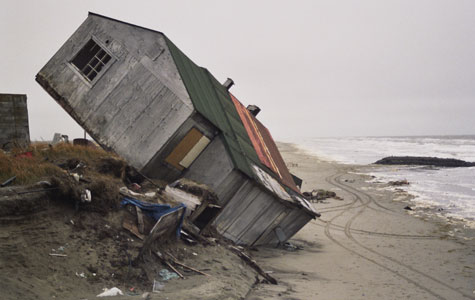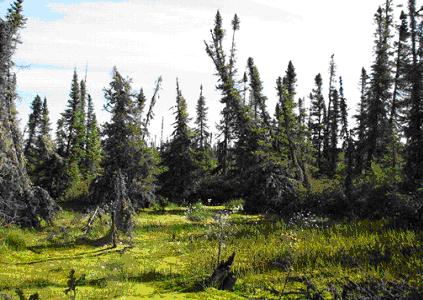Hydrological Factors
In the Arctic, ice rich continuous permafrost inhibits water from percolating deep into the ground. As a result, these soils tend to be very moist. Permafrost thaw in these continuous zones would allow this excess water to reach the water table, effectively drying the ground surface. This condition can lead to reduced river flow, lake disappearance, wildfire and susceptibility to lightning strikes. In contrast, in lower Arctic regions of discontinuous permafrost, the water easily percolates through the unfrozen surface to the water table, leaving the soils relatively dry. When permafrost thaw occurs, more water is available to flood this type of environment (Figure 1) (SWIPA, 2011).
Greenhouse Gas Release
The estimated quantity of greenhouse gases stored within Arctic permafrost is higher than previously believed. It is projected that the surface few meters of permafrost may hold 1024 Gt of organic carbon. Modelling results indicate that between 50 to 250 Gt of carbon may be released by the end of the century (IPCC, 2013). That carbon stock (in the form of carbon dioxide and methane) represent approximately 45% of the Earth’s total carbon trapped in soil. When permafrost warms, these previously frozen, trapped gases are mobilized (Figure 2). This mobilization allows gases to easily escape into the atmosphere. The rate of release of the available permafrost greenhouse gases is unknown. However, the potential organic gases to be release with permafrost thaw (carbon dioxide, methane, nitrous oxide) are anticipated to influence the greenhouse gas effect of the regional, and possibly global, climate regime (SWIPA, 2011). Currently, NASA is monitoring levels of carbon release across the Arctic with the CARVE mission (Carbon in Arctic Reservoirs Vulnerability Experiment). CARVE has discovered that at present, some parts of the Arctic, such as the Yukon River wetlands, are releasing 650 ppb more carbon than usual (Oskin, 2013).
Infrastructure Damage
Current infrastructure built in permafrost regions depend on perpetually frozen ground for support. As permafrost thaws, and ground volume decreases, the surface distorts. This distortion alters the building structure integrity (Figure 3). Transportation routes such as train tracks and roads are also susceptible to damage (SWIPA, 2011).
Land Instability
The melt of permafrost decreases the stability of the land surface, resulting in features such as thermokarst formations and thaw slumps. These sudden alterations of ground condition increases the frequency of inland rockfalls and landslides. Melt of coastal permafrost has been shown to reduce the lands ability to withstand wave abrasion, degrading the shorelines. This coastline collapse increases sediment discharge into the oceans (Figure 4). The process of increased ground instability affects vegetation cover. Trees in the Arctic influenced by permafrost melt have been termed drunken forests (Figure 5) (SWIPA, 2011).
Permafrost: The Tipping Time Bomb Video from Yale Climate Forum on YouTube.
Material for this page was provided by Maren Pauly, Department of Geography, University of Waterloo.





